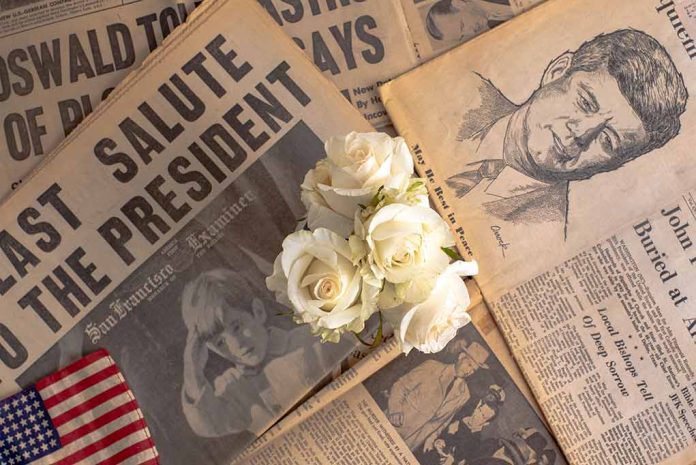
Newly released JFK assassination files reveal CIA surveillance of Lee Harvey Oswald before the fateful day, yet crucial questions remain about the spy agency’s possible involvement in both the murder and subsequent cover-up.
Key Takeaways
- Recently declassified JFK files contain over 77,000 pages of documents released by the National Archives, providing new insights into CIA operations.
- While the documents don’t contradict the Warren Commission’s conclusion that Oswald acted alone, they reveal extensive CIA surveillance of Oswald before the assassination.
- The files expose significant CIA infiltration in foreign embassies and Fidel Castro’s inner circle, with 14 Cuban diplomats and two ambassadors serving as CIA agents.
- Expert Frank De Varona suggests possible architects of Kennedy’s assassination include Lyndon Johnson, Allen Dulles, Fidel Castro, and organized crime elements.
- Despite the release, many documents remain partially redacted, and files held by the CIA, FBI, and National Archives have still not been made public.
New Revelations from Declassified Documents
In what Jefferson Morley called “the most exciting news around JFK records since the 1990s,” the Trump administration’s release of declassified documents related to John F. Kennedy’s assassination has reignited public interest in one of America’s most enduring mysteries. The National Archives and Records Administration released over 77,000 pages of previously classified or heavily redacted materials, offering historians and researchers unprecedented access to information about the events surrounding November 22, 1963. While the documents don’t definitively answer who killed Kennedy, they provide valuable context about intelligence operations during that period.
The files reveal the CIA maintained extensive surveillance of Lee Harvey Oswald long before the assassination. “He’s a subject of deep interest to the CIA long before the assassination, and the extent of this has only become clear in the last few years,” noted Jefferson Morley, a prominent researcher on the case. This contradicts earlier official narratives that portrayed Oswald as a peripheral figure who wasn’t on the intelligence community’s radar prior to Dallas. The documents specifically detail Oswald’s trip to Mexico City and his interactions with the Soviet embassy in the weeks before the assassination.
CIA Operations and Cold War Activities
Perhaps the most surprising revelations concern the CIA’s extensive infiltration of foreign governments during the Cold War. The newly unredacted documents show the agency maintained a significant presence in American embassies, sometimes comprising up to 40-50% of embassy personnel. More shockingly, the files reveal that 14 Cuban diplomats were actually CIA agents, and two Cuban ambassadors provided valuable intelligence to the United States. These discoveries provide concrete evidence of the depth and breadth of American intelligence operations aimed at monitoring and potentially destabilizing communist regimes during the Kennedy administration.
“With respect to the assassination, there’s little or nothing that’s new, at least in terms of what I’ve been able to see thus far. I can’t say I’m surprised—going in I didn’t expect we’d learn anything that would overturn our understanding of what happened in Dallas,” said Fredrik Logevall, Pulitzer Prize-winning Kennedy biographer.
These revelations have added fuel to long-standing theories about potential CIA involvement in the assassination. Historian Fredrik Logevall notes that while the files themselves don’t directly contradict the Warren Commission’s conclusion that Oswald acted alone, they do reveal institutional patterns of deception and covert action that make some conspiracy theories more plausible. The documents show the CIA’s willingness to engage in questionable activities abroad, raising questions about what actions they might have taken domestically against perceived threats to American interests or their organizational power.
Deep State Theories and Potential Conspirators
Veteran analyst Frank De Varona has drawn attention to the files’ implications regarding a potential CIA cover-up. “The Trump administration’s newly released John F. Kennedy assassination files may not point directly to who shot the president, but they do expose the CIA and indicate a massive coverup,” De Varona states. He points to several powerful figures who potentially had motives to eliminate Kennedy, including then-Vice President Lyndon Baines Johnson, former CIA Director Allen Dulles (whom Kennedy had fired), Cuban dictator Fidel Castro, and organized crime elements that had been targeted by Kennedy’s Justice Department under his brother Robert.
“There’s reason to believe he talked openly about killing Kennedy in Mexico City and that people overheard him say that,” said author Philip Shenon, who wrote a book about the Kennedy assassination in 2013.
The assassination continues to fascinate Americans partly because of subsequent events that fueled suspicion. Oswald’s murder by Jack Ruby before he could stand trial eliminated the possibility of a thorough investigation of his motives and potential connections. The Warren Commission, established to investigate the assassination, has been criticized for its rushed timeline and reluctance to explore certain avenues of investigation. Additionally, the graphic nature of the Zapruder film, which captured the assassination, has led generations of Americans to analyze the footage frame-by-frame, looking for evidence of multiple shooters or other inconsistencies with the official narrative.
Transparency and Ongoing Questions
Despite President Trump’s claims that the files were completely unredacted, researchers have noted that many documents still contain redactions. Moreover, significant collections of documents held by the National Archives, CIA, and FBI remain unreleased. The partial nature of this disclosure has led some critics to suggest the most damaging information remains hidden. Researchers particularly point to remaining questions about Oswald’s activities in Mexico City shortly before the assassination, where he allegedly visited both Cuban and Soviet embassies and may have openly discussed plans to kill Kennedy.
The assassination of John F. Kennedy continues to represent a pivotal moment in American history, often described as the end of American innocence. The continued interest in these files reflects ongoing public concern about government transparency and the potential for what many now call the “Deep State” to operate beyond democratic oversight. While definitive proof of CIA involvement in Kennedy’s assassination remains elusive, these newly released documents provide important context about the agency’s capabilities and willingness to engage in covert operations during a tumultuous period in American history.
Sources:
- https://www.bbc.com/news/articles/cly676jp291o
- https://news.harvard.edu/gazette/story/2025/03/declassified-jfk-files-provide-enhanced-clarity-on-cia-actions-historian-says/
- https://thenewamerican.com/?p=418800










